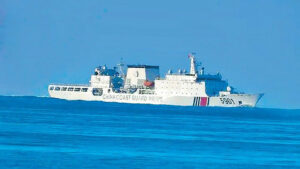A recent discovery by NASA satellites has captivated the imagination of scientists and enthusiasts alike—a mysterious ghost island that briefly emerged in the Caspian Sea before vanishing without a trace. This enigmatic landmass, formed by the eruption of a mud volcano off the coast of Azerbaijan, has left experts marveling at the immense and unpredictable forces of nature capable of creating and erasing landscapes in the blink of an eye. Observed over the span of two years, the island’s fleeting existence has sparked questions about the underlying processes that gave rise to this transient phenomenon. How did such a landmass form so quickly, only to succumb to the unrelenting forces of erosion? More importantly, what can this event reveal about the unique geological features of this tectonically active region, where the Earth’s plates collide and reshape the landscape in real-time?
A Brief Appearance, Then Gone
According to NASA Earth Observatory, the island appeared early in 2023, emerging from the depths of the Caspian Sea after a powerful mud volcano eruption. Satellite images captured its sudden birth and equally swift disappearance, with the landmass retreating “like an apparition.” This “ghost island” quickly became a point of fascination, not just for its impermanence but also for the dramatic way it showcased the region’s geological volatility.
Mud volcanoes are unique geological features capable of ejecting mud, gas, and sediment in explosive bursts. The Kumani Bank mud volcano, also known as Chigil-Deniz, is one of the most active examples in this part of the world. “Powerful eruptions of the Kumani Bank mud volcano have produced similar transient islands several times since its first recorded eruption in 1861,” explained NASA. This recurring phenomenon highlights the dynamic interplay of tectonic forces in the Caspian region, where landforms can appear and disappear within months.


A History of Transient Islands
The Kumani Bank volcano, located about 25 kilometers (15 miles) off the eastern coast of Azerbaijan, has a storied history of creating short-lived islands. Its first recorded eruption in May 1861 produced an island just 87 meters (285 feet) across and 3.5 meters (11.5 feet) above the water. “This one eroded away by early 1862,” NASA noted, illustrating how such landmasses often succumb to the relentless forces of wind, waves, and erosion.
The 2023 eruption followed a similar pattern, albeit with modern technology offering a closer look at the process. Satellite imagery from NASA’s Landsat 8 and 9 documented the island’s lifecycle, capturing its formation and eventual erosion over two years. By late 2024, the once-visible island had vanished, leaving only a diminished portion of the Kumani Bank above the water. These disappearing acts are not just geological curiosities; they also provide valuable insights into the forces shaping the Earth’s surface.
The Role of Tectonic Forces
The Caspian Sea region is uniquely positioned within a tectonic convergence zone where the Arabian and Eurasian plates collide. This geological activity has made Azerbaijan a hotspot for mud volcanoes, with more than 300 identified in the area, many of which are located on land. “Geologists have tallied more than 300 in eastern Azerbaijan and offshore in the Caspian Sea, with most of those occurring on land,” NASA said.
Mud volcanoes in this region are known for their unpredictability and potential for dramatic eruptions. While it is unclear if the 2023 Kumani Bank event was fiery, NASA noted that previous eruptions in the area have sent towers of flame hundreds of meters into the air. This explosive activity, combined with the rapid accumulation and erosion of sediment, makes the phenomenon of ghost islands both a scientific puzzle and a visual spectacle.
The Science Behind the Mystery
Mud volcanoes are largely understudied, yet their behavior holds significant clues about subsurface activity and tectonic processes. These eruptions occur when underground pressures force mud, gas, and sediment to the surface, often in areas with abundant hydrocarbons. The Caspian region’s geological richness, coupled with its tectonic activity, creates ideal conditions for these dramatic events.
“Most mud volcanoes are found in areas with active tectonics,” said researchers, noting that Azerbaijan’s concentration of these features is unusual. The Kumani Bank mud volcano, in particular, has produced islands of varying sizes and durations over the decades, with the 2023 eruption offering a rare opportunity to study the phenomenon in real-time through satellite monitoring.
A Hazard and a Wonder
While ghost islands like the one in the Caspian Sea are fascinating to study, they also underscore the potential hazards of mud volcanoes. The sudden release of gas and sediment can pose risks to nearby environments and infrastructure. Additionally, the fiery eruptions witnessed in the past highlight the volatile nature of these geological features.
“It is uncertain if the 2023 Kumani Bank eruption was fiery,” NASA added, “but past eruptions of this and other nearby mud volcanoes have sent towers of flame hundreds of meters into the air.” This unpredictable behavior serves as a reminder of the powerful forces at play beneath the Earth’s surface.
Got a reaction? Share your thoughts in the comments
Enjoyed this article? Subscribe to our free newsletter for engaging stories, exclusive content, and the latest news.









Leave a Comment